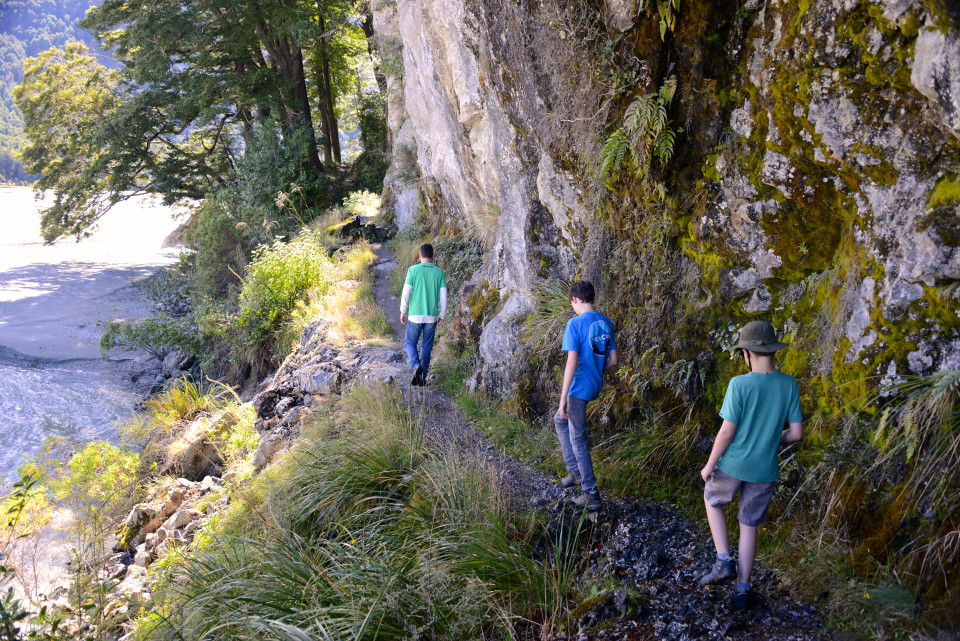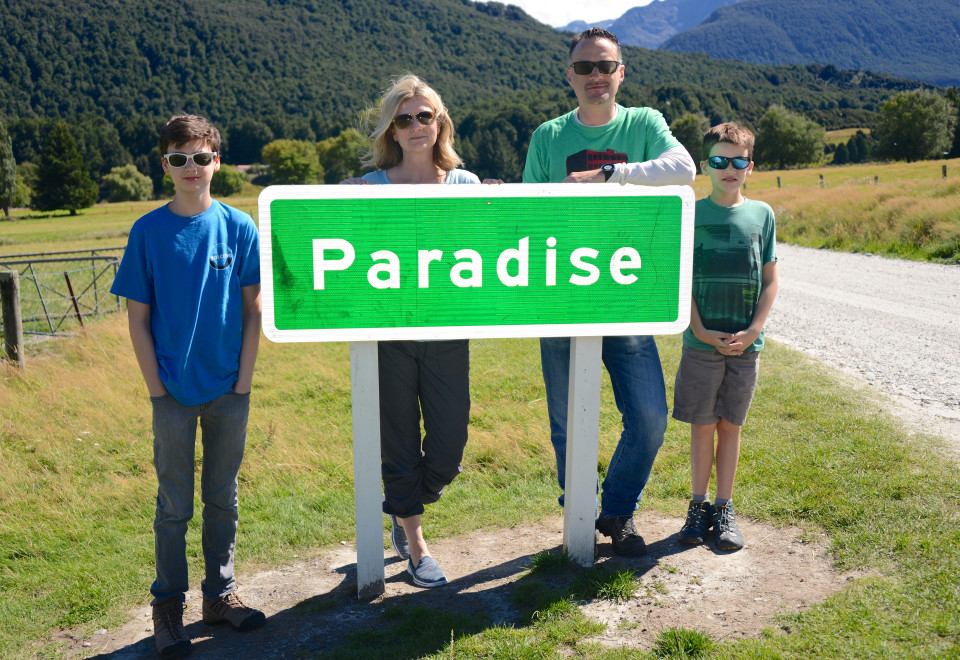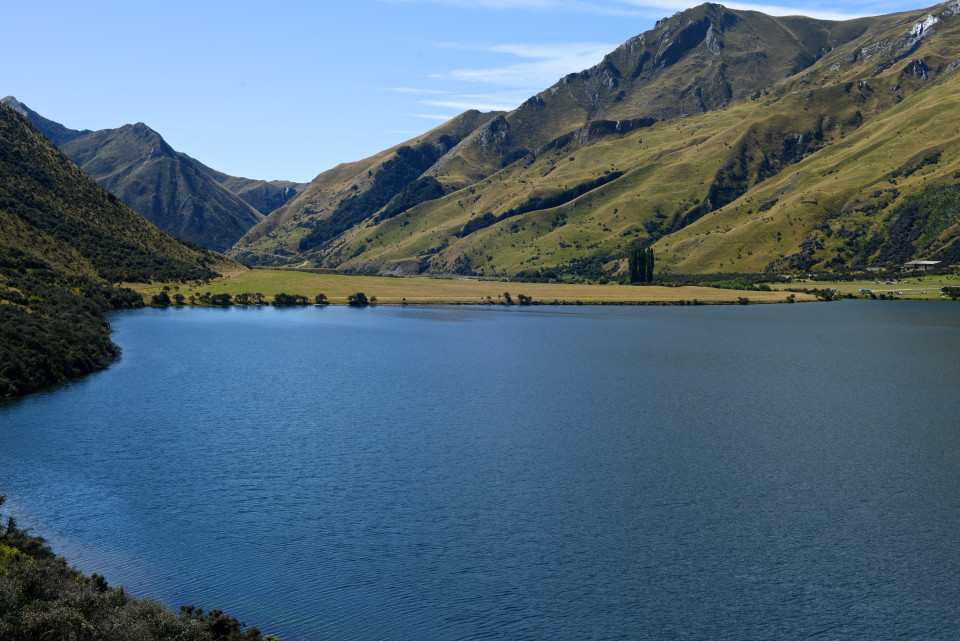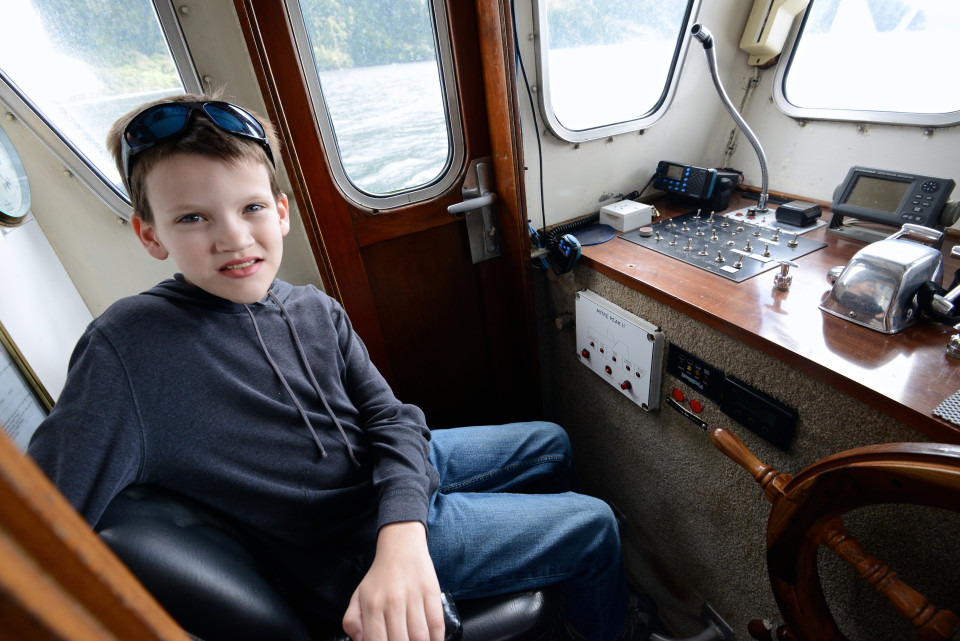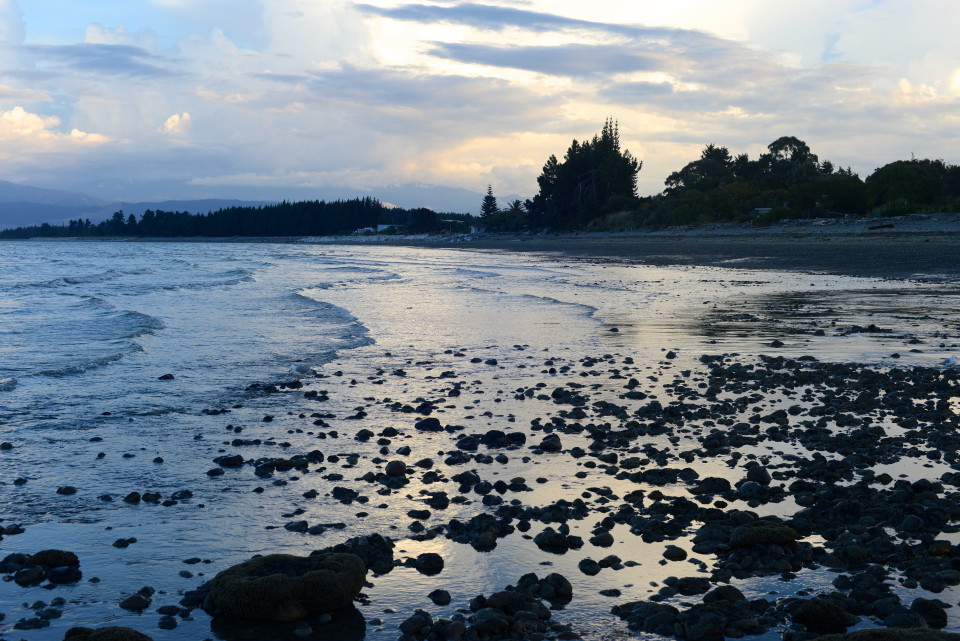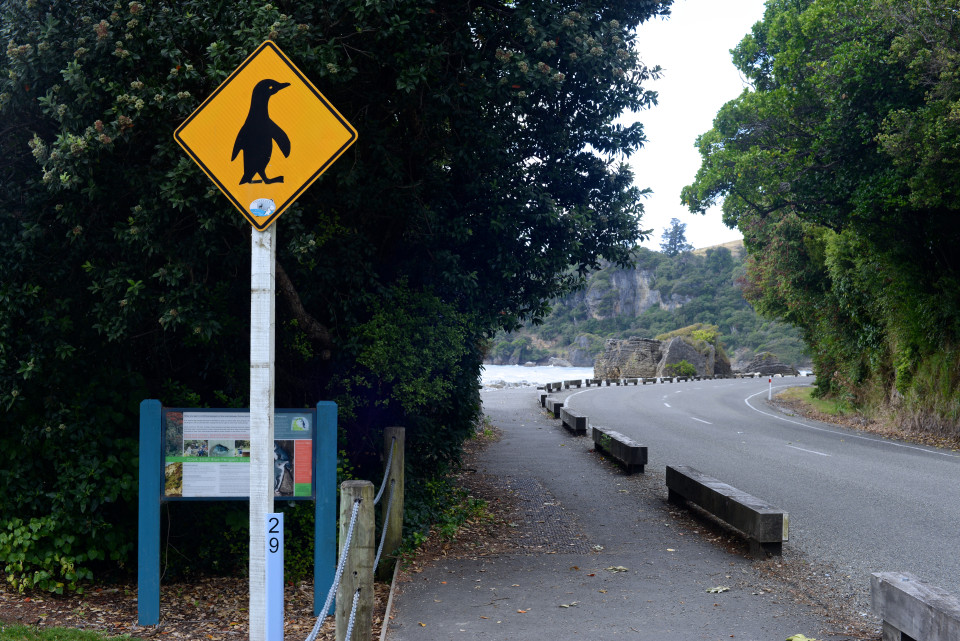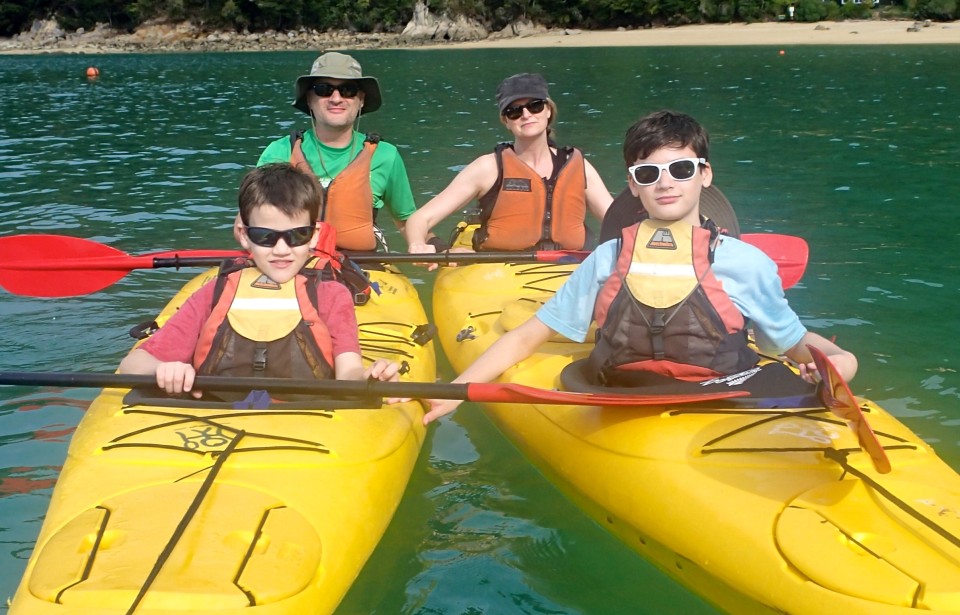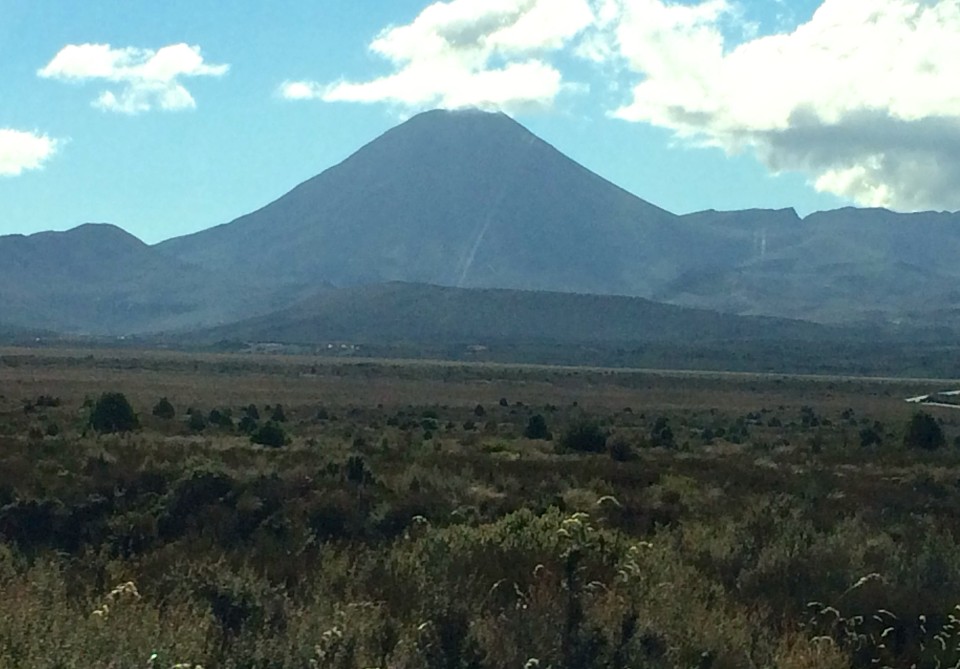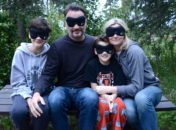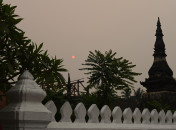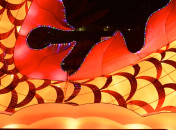Early starts are part and parcel to life on the road, but getting the family up at 1:00a to drive an hour and a half for a 5:00a flight from Cairns, AU to Queenstown, NZ was quite difficult. The one highlight was a chance encounter with perhaps 50 grazing wallabies, at a traffic circle that we looped a couple of times so Asher could get a good long look. No other vehicles graced the drive and the rural path along the edge of the rainforest had few streetlamps, so it was dark and lonely.
Queenstown (aka Tahuna, in Maori) is a resort town in the southwest part of New Zealand’s South Island. Our approach brought us low over the lightning bolt-shaped Lake Wakatipu through a gap in the surrounding mountains. Many would recognize the picturesque setting for its role in the “Lord of the Rings” movies and in Jane Campion’s excellent “Top of the Lake” series. As with any resort town, it was brim-full of tourists and loaded with restaurants, shops and cafés.
Our apartment overlooked the lake and was close enough to town that we could walk. The only challenge was the rain, which would come on suddenly; as we didn’t have an umbrella, it forced us to be mindful of when we’d leave the house.
GATEWAY TO MIDDLE EARTH
About an hour from Queenstown up at the northern spur of Lake Wakatipu is the village of Glenorchy. It is a nexus for many hiking tracks throughout the region and is a village of equal parts charm and beauty. It is also exceptionally proud of its role in the LOTR movies. After a short tramp around the wetland flats of the Rees River, we stopped briefly at a café with dozens of production pictures from the movies hung in perfect alignment across its wall. Ya gotta go to Paradise, the man said and pointed at a map on the wall. That’s where they filmed most of it.
About forty minutes outside of Glenorchy, we found Paradise. Bucolic is an apt description of the setting. It is a beautiful region that, like so much of New Zealand, reminded us of parts of the American West, especially California. The main difference was that here were sheep instead of cattle, with great herds sprawled across the golden lowlands. Amidst the dusty clapboard farmhouses and rocky gullies, a single road sign was the only indication that we’d found our destination. Other people were using the spot to turn back to town, but we pressed on.
It’s become a bit formulaic in our travels…when the road turns rough, I threaten to turn around, but don’t. The allure of surprise holds too fast to the wandering heart. We forded several broad streams, a couple with blue-water holes in them, and eventually came to a loop with a couple of camper vans and families picnicking nearby. From there we tramped into the beech and fern forest along an undulant track with fallen branches and steep cliffs. The other part of our formula is that when hiking, we turn back when it becomes obvious we cannot continue, which in this case was about a mile in. A slide had wiped out the trail along a dangerous route high above the glacial river below us. Time to go home.
Along our trail and throughout the South Island, we saw an abundance of warning and protest signs regarding the use of the pesticide 1080. While we were there, a guerilla environmental organization claimed they’d put 1080 in the nation’s dairy supply to protest the inadvertent killing of pets. 1080 is distributed as bait pellets from airplanes for the purpose of ingestion by the non-native fauna – mainly rats, weasels and the common brushtail possum. The public debate regarding the poison’s usage was loud and prevalent during our three weeks in New Zealand.
TOP OF THE LAKE
Near Queenstown, a steep road zig-zags up into the spurs of the Southern Alps, and high-end holiday homes give way to farmhouses and sheds. Toward the end of a gravel road is Moke Lake, which offered us a solid 8-mile loop hike. The lake, or more precisely, the flat field that runs up to its northern edge, was the location of GJ’s (played by Holly Hunter) refugee village in “Top of the Lake.” The day was bright and windy, and perfect for a long walk.
Arrowtown is an historic gold mining town (see western U.S.) in the Otago region northwest of Queenstown. Our aim was to visit the town, maybe shop a little and relax after the hike. The town was truly golden as the sycamores’ autumnal turn cast the shaded parks and sidewalks in a heavenly glow. Unfortunately, it also was mobbed by tour buses and the gift shops were repetitive – offering the same stack of postcards, Maori carvings, and little gold-mining tchotchkes – so it ended up being a short visit. Asher and I made the most of it by settling in at a local watering hole, the Fork and Tap, and enjoying a pint and bowl of lemon-salt French fries.
CAPTAIN ASHER
We said goodbye to Queenstown by posting our vehicle registration form to the State of California – proving that some things cannot be avoided no matter how far you travel. We then headed toward Milford Sound for a 1:30 boat tour. The drive through Te Anau and the Fiordland National Park was stunning, with awe-inspiring views of the surrounding mountains, rich flora and mirror lakes. Despite the heavy rain forecast for the day, the sky cleared just as we left the dock.
‘The fair breeze blew/The white foam flew/And the forrow followed free/We were the first to ever burst into the silent sea.’ – Samuel Taylor Coleridge, The Rime of the Ancient Mariner
A refitted fishing vessel, our boat was large enough to accommodate 40+ passengers through the sound and into the choppy Tasman Sea, where swells regularly reach five meters. There were only 13 aboard for our tour, making it feel a little like a personal yacht.
While Angela walked the upper deck, Asher, Ronan and I sat quietly in the lower deck enjoying the scenery. I mentioned that I’d seen chocolate chip and butter cookies upstairs, and Asher immediately disappeared under a promise to bring me back a cookie or two. Fifteen minutes passed and he hadn’t returned. He didn’t take long to find – he was standing at the bridge steering the ship under the careful guidance of the captain. Asher has a knack for getting himself invited into ‘behind-the-scenes’ activities, so we double-checked that it was okay with the captain, who simply nodded and said, ‘he’s a good kid.’
The swells at the edge of the sound and sea were much greater, pitching our suddenly small-feeling boat back and forth as we turned around toward port. As the engine settled into a lower idle, we seemed to be zigzagging, first toward shore then back out toward the open sea. What would we do if the boat starting sinking, Ronan asked. It won’t sink, I said and suggested that the captain was steering this way to dampen the effects of the swells, or to avoid another vessel. But at that moment, the skipper casually walked by and locked himself in the restroom. Who’s steering the ship, Dad? The only other person I had seen on the bridge was Asher, who Ronan and I, looking at each other, panicked must be alone at the wheel.
“I know not all that may be coming, but be it what it will, I’ll go to it laughing.” – Herman Melville, Moby Dick
OUR CONFIDENT CAPTAIN
Asher was still basking in the glory of being co-captain when we arrived in Te Anau. Feeling like luck was on his side, he offered to find a restaurant for dinner and immediately jumped on the internet while we settled in to our ‘cabin.’ The cabin was a converted workshop decorated like an elderly aunt’s house, complete with lace doilies draped over the top of the tube television. We didn’t care though – we just needed a place to sleep and the beds were fine.
We knew Ash would pick a pizza place because, well, because he’s Asher and he’s ten. However, we had no idea that he’d score us one of the best pizzas we’ve ever had. Seriously, the place was right up there with Shakespeare’s. La Toscana was the perfect ending to a very long day of sea and road.
TE ANAU TO DUNEDIN
Asher’s good luck did not transfer to the following day, as the GPS seemed to find every gravel road and convoluted backcountry byway across the farmland separating us from Dunedin. If I hadn’t been so burned-out on driving, it would have been a fine route. The scenery was spectacular, with large farms and estates spread across the green rolling hills rimmed by eucalyptus and yucca palms. Sheep outnumbered people many times over, and there were no tour buses nor gift shops the entire day.
Dunedin is the second largest city on the South Island and a surprisingly vibrant university town. While there we drove along the Otago Peninsula out to the Royal Albatross Centre, which studies and protects the only mainland-based albatross nesting area in the world. We learned that the large birds are very particular about where they nest, and they spend the first 5 years of their lives at sea before returning to land to mate. We also visited the well-curated Toitu Otago Settlers Museum, a regional history collection of the Otago Province native and immigrant cultures.
GLACIER IN THE JUNGLE
It was a long drive from Dunedin to Fox Glacier, the last hour through a lush rainforest with massive treeferns and carpet mosses beneath its canopy. The winding road that edged the mostly rocky coast provided infrequent glimpses of the high, snow-capped mountains above us to the east. Fox Glacier is the name of both the glacier and the village below, and just south of town we turned off the main road to see and photograph the famous and deadly glacier.
The Fox Glacier falls an incredible 8,500 ft on its journey from the Southern Alps to the jungle; it is the largest and longest glacier on NZ’s west coast. It also owns the distinction of being one of the few glaciers in the world to end in a rainforest. We intended to drive to the lookout, snap photos and stretch our legs, but the parking lot sat behind a spur of the mountains that hid the true viewing point another two miles up the valley.
TELLTALE HEART
The trail, like so many, was easy and accessible at first but unveiled a secret as it progressed. It wasn’t long before we’d forded three washout streams, stepping carefully across massive granite stones, and traversed areas with recent rockslides and slippery mud. It’s common for us to separate a bit when we pass over difficult stretches, but Angela had fallen back quite a bit and was taking a lot of pauses. I backtracked to check on her, and she mentioned that her heart rate was way up and she was short of breath – much more so than she’d typically be on that level of climb. She eventually made it through the glacier loop, but definitely needed more rest stops than usual.
THE BEACH HO– USE
After a nice dinner and a lot of sleep, we headed north toward Nelson. Angela seemed to be feeling better but clearly wasn’t 100 percent. Fortunately we had about six hours in the car ahead, so at least she could rest.
We arrived at our rental beach house in Ruby Bay loaded with provisions for four days of home-cooked meals. After a brief walk-thru with the owner, we explored the seaweed-coated rocks on the other side of the low natural seawall that protected the back terrace. Asher and Angela discovered all kinds of small creatures on the beach – pinky-nail sized sea stars, anemones crabs and crab eggs. As I prepared dinner with an open window, the warm sub-tropical breeze carried the gleeful sounds of discovery from my family.
Over the next few days, we fought the urge to call off the rest of our journey and settle permanently in the simple, cozy beach house. One of the afternoons the boys competed in a tower-building contest using flotsam found on the beach. Angela and I enjoyed the shaded back deck, with its planks worn smooth to the silver patina of aged driftwood and the frazzled furniture showing years of rips and repairs. The BBQ looked like it knew more about sacrifice than a grove of Texas mesquite; scabs of blackened marinade burned down the side of the basin. The surrounding yard was filled with lime, lemon, peach, fig and apple trees. This was the Garden of Eden.
TELLTALE HEART II
Our plan to drive through Abel Tasman National Park was thwarted. The southern entrance to the park was only for backpacking or day hikes, and we’d prepared for neither. If we wanted to drive through the park we’d have to loop around it, switchback our way up and over the surrounding mountains and enter from the northwest. It was a nice enough day – partly sunny and periodically spitting a soft rain. Despite the protestations of the boys who wanted to relax more in Eden, we set out for Takaka.
The drive was steep and at times precarious, and the switchbacks that turned the road upon itself were disorienting. It was particularly uncomfortable for Angela, who still wasn’t feeling clear-headed but couldn’t name why. I drove as steadily I could to try to ease her suffering. The road eventually flattened out in the long and broad valley toward Takaka, a small town situated at the southeastern end of Golden Bay. According to Lonely Planet, Takaka owns the ‘highest concentration of yoga pants, dreadlocks and alternative life-stylers’ in New Zealand. We were a bit disappointed not to find a Blue Dixie t-shirted dude selling beads, but the beautiful farming region led us along the edge of the bay to Pohara. There we encountered our first ever penguin crossing signs and the memorial to the murdered sailors of Abel Tasman’s reconnaissance team.
KAYAKING IN ORCA TERRITORY
It was early and foggy, the sun an orange seam barely visible in the distance, as we embarked on a kayak excursion along the coast of Abel Tasman National Park. I found a cup of coffee as Angela checked us in for our tour. Our guide Christy, aka Brownie, set us up with paddles and kayak skirts before leading us on a quarter mile walk over the low-tide shoal to the bay. We teamed up into two-person kayaks, Ronan with Angela and Asher with me. The warm-up was finding a rowing rhythm as we skirted the edge of the mainland shore. Once we settled into a groove, Christy escorted us across the boat lane where the park’s water taxis and other traffic zipped back and forth.
At Adele Island, beyond a nice leeward harbor for sailboats, we saw around 100 sea lions resting on the rocks. We learned that with that volume of sea lions (prey), it wasn’t uncommon to see a pod of orcas (predator) prowling the waters. We all wondered what our kayaks must look like to an orca. As we circled around to the island’s north side, the billowing sea began to challenge our paddling skills so we turned back toward mainland and lunch. After a short break on the beach we said goodbye to Christy and headed into the jungle for a hike to Anchorage, our pick-up station for the water taxi back to Marahau.
CROSSING THE STRAIT
The route from New Zealand’s South Island to North Island included more winding roads and a ferry. It also meant leaving our trusted Toyota Highlander behind, as the rental car companies maintain fixed inventory on each island. A new car awaited us on the other side.
The Cook Strait is notoriously moody. We’d seen video of how gale force winds can affect the massive 1,500-person ferries on the 3.5 hour journey, but were cautiously optimistic that our sunny day would provide a smooth ride. We lucked out and landed in Wellington for what we expected would be a short two-night stay.
NEW ZEALAND HEALTHCARE SYSTEM
Te Papa Tongarewa (Museum of New Zealand) is highly regarded and listed by most travel sites as the #1 attraction in Wellington. The museum was only one flat kilometer from the hotel, and although it was chilly and raining, we decided to walk. As soon as we started out, Angela noted she really wasn’t feeling well. By the time we reached the museum, her heart was racing above 150 bpm and each breath was a strained heave. We called her doctor’s office at home, who suggested she be seen by a professional right away. The last thing you want when traveling is to rely on an unfamiliar healthcare system for urgent care, but we had no choice.
In the end, the most remarkable piece of this story was the emergency room experience itself. In the five hours of care she received there, Angela was seen by four physicians, including an attending doctor who spoke with her at least a dozen times. Everyone went by first names – including the physicians, even on their badges. There was almost no sense of “hierarchy” among the staff, with everyone cooperative, transparent and kind. None of Angela’s doctors seemed rushed, often spending long sessions asking and answering questions and explaining their thoughts, even as their hypotheses changed. They also wrote up incredibly detailed notes in case we needed to show them to other providers as we traveled.
In addition to physician and staff care, Angela received several diagnostic procedures and many lab tests – items that easily would cost thousands of dollars at a US hospital. Ultimately the team determined that she was having an unusual reaction to a medication, and that with a dosage adjustment and counteracting drug, she should start improving in a few days to weeks. They put her on IV meds to jump-start the process and as her heart rate started to come down a bit and it looked like she could go “home” that day, her attending physician came in to review her case and next steps. He then provided a lengthy, somewhat embarrassed apology that because we weren’t NZ citizens, we’d have to pay out-of-pocket for the day’s care. When she was ready to leave, her doctor – not a nurse or orderly – wheeled her to the desk so we could sign out. Grand total for five hours of physicians’ time, top-notch nursing care and a battery of advanced procedures and lab tests? $323. With apologies.
LEARNING ABOUT MIDDLE EARTH
Since it would take a couple of days for her medication to start helping and we’d need a local doctor to evaluate ongoing treatment, we decided to extend our stay in Wellington from two nights to five.
With time to burn while Angela rested at the hotel, the boys and I finally got to explore Te Papa Museum. We saw all sorts of sea creatures, including a giant squid in a Lucite brick of preservative and a 100-foot-long immature pygmy blue whale skeleton strung on wires across the ceiling. A highlight of the museum was an exhibit dedicated to the voices of New Zealanders sharing how they are connected to the land. One clip told of a Chinese immigrant who absorbed the local Maori culture so earnestly that he was made the local tribe’s chief. Another shared the story of a wealthy sheepherding family who gave their thousands of acres of pristine mountains to the government so that others could enjoy the land. The museum also contained many native Maori artifacts, ‘The Lord of the Rings’ set pieces and a history of New Zealand Airlines (its major corporate sponsor, ahem).
Our final day in Wellington consisted of just two things – a visit with a local physician and a follow-up round of tests for Angela. After the phlebotomist, she ended her 24-hour fast and we hit the road, grateful to put the city in our rearview mirror.
SHOULD WE STAY OR SHOULD WE GO?
The healthcare system in New Zealand was outstanding and we figured that Singapore would be very good too. Our big concern was if something were to happen with Angela while we were in Viet Nam, Laos or Cambodia – none of which has the best reputation when it comes to medical expertise. Our big decision was whether to continue our journey or return to the U.S. so that Angela could fully recover. The boys and I felt it best to get her healthy rather than risk it, but she felt she could make it through and indeed seemed to be improving already.
Under the assumption that we were continuing, we needed to make it to Auckland in less than 48 hours to catch our flight to Singapore. That meant a long, hard day of driving. It also meant that we’d have to revisit New Zealand in the future for a proper tour of the North Island.
The drive could have been done more easily in two days, but I wanted to give the family a down day before the 10-hour flight. The route took us across the central volcanic zone that included the dramatic peaks of Mount Tongariro and Mount Ngauruhoe, the latter of which was featured in the LOTR movies as the literary Mt. Doom. The area was gorgeous, but unfortunately viewed at 100km/hour.
It was 7:00p when we arrived in Auckland. We didn’t have hotel reservations or any idea where to eat, but Angela jumped on the city-wide free wifi and got us square for the night.
VACATION ISLAND
The flight to Singapore was on a giant A380 operated by the best airline in the world, which eased the pain of the long journey. After three eventful weeks in New Zealand, we were physically and emotionally drained and looked forward to a bit of R&R.

